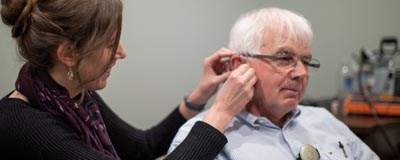Hearing loss is attributed to many factors such as aging, noise exposure, premature birth, and genetic transmission. On the other hand, hereditary hearing loss is not often discussed. Hearing disorders known as “endogenous” are hereditary patterns in hearing loss passed on through generations. These hearing losses are transmitted as a genetic trait. There are three transmission route which occur during the fetal stages of development, autosomal dominant inheritance, autosomal recessive inheritance, and sex-linked inheritance.
Autosomal Dominant Inheritance
In this mode of transmission, one parent carries the genetic trait which has a 50% chance of being transmitted to the child. Both the mother and the father can carry and transmit the genetic trait. Well known autosomal dominant conditions linked to hearing loss are Waardenburg syndrome, Branchio-otorenal syndrome and Neurofibromatosis 2.
Autosomal Recessive Inheritance
While these conditions are quite rare, transmission is only possible if both parents carry the genetic trait. Well known autosomal recessive conditions that create a hearing loss are Usher syndrome and Pendred syndrome.
Sex-linked inheritance
The genetic trait is found on the sex-determining chromosome. As we know a combination of two X chromosomes create a female (XX), and a combination of an X and Y chromosome create a male (XY). Transmission of the sex-linked inheritance is quite complicated, however, we’ve provided a brief breakdown on how it works:
If the father is affected: The females will be carriers, and unaffected. The males will be unaffected.
If the mother is a carrier:
The females have a chance of being carriers, and the males have a chance of being affected. There is no statistic available to say what chance each sex has of carrying or being affected.
Hearing loss caused by a sex-linked condition is very complex and only represents 2-3% of all hearing losses. A well-known sex-linked conditions linked to hearing loss is called Alport syndrome.
Nonsyndromic Hereditary Hearing Loss
The genetic conditions listed previously were syndromes, but hearing loss can also originate from a nonsyndromic hereditary hearing loss. These hearing losses are caused by hereditary mutations in various genes. As a result, these genetic mutations can present themselves at birth or later in life. There are over 30 different genes in our DNA that can mutate and result in hearing loss. In fact, these mutations are so common that 70% of hereditary hearing losses are nonsyndromic.
The complexity of genetics explains why there is often no root cause detected in hereditary hearing loss. Is the recent years, many researchers began studying the use of stem cell therapies to restore sound. Their inspiration to use this technique comes from the advances in eye gene therapy. However, much of this research is still in clinical trial. Fortunately, research continues to make advances for the prevention and treatment of hearing loss.
References:
Taylor, B., Mueller, G. (2017) Fitting and Dispensing Hearing Aids, Plural Publishing, San Diego CA
Zhang, W., Kim, S. M. (2018) Cochlear Gene Therapy for Sensorineural Hearing Loss: Current Status and Major Remaining Hurdles for Translational Success, Frontiers In Molecular Neuroscience, 11 ; 221, doi: 10.3389/fnmol.2018.00221






